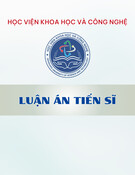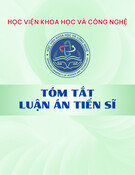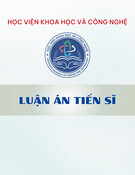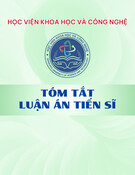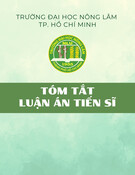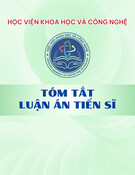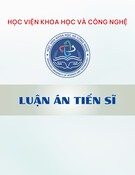MINISTRY OF EDUCATION AND TRAINING HANOI NATIONAL UNIVERSITY OF EDUCATION
NGUYEN THI PHUONG DUNG
STUDY ON THE EFFECTS OF LED ON SOME
PHYSIOLOGICAL CHARACTERISTICS, YIELD AND QUALITY OF HYDROPONIC CULTIVATED SPINACH (Spinacia oleracea L.) Major: Plant physiology
Code: 9.42.01.12 SUMMARY OF PhD THESIS IN BIOLOGY
HANOI - 2021
The study is completed at: HANOI NATIONAL UNIVERSITY OF EDUCATION
Proposed supervisor: 1. Prof. PhD. Nguyen Quang Thach
2. Assoc. Prof. PhD. Tran Thi Thanh Huyen
Reviewer 1: Assoc. Prof. PhD. Mai Van Chung Vinh University
Reviewer 2: Assoc. Prof. PhD. Nguyen Van Dinh HaNoi Padagogical University 2 Reviewer 3: Assoc. Prof. PhD. Nguyen Quang Huy
VNU University of Science
The thesis is defended before Thesis Examination Board at University level held at Hanoi National University of Education at …..hour … date … month… year 2021
The thesis could be found at Library: National Library of Vietnam, Hanoi Library of Hanoi National University of Education
PREAMBLE
1. Reason to choose the study
Green vegetables are an important food source in providing essential nutrients for humans every day. Some vegetables are also considered as functional foods, used as valuable medicinal herbs to enhance health and prevent diseases. Spinach (Spinacia oleracea L.) is a plant with high nutritional value which contains many vitamins (A, K, D, E), minerals (Fe, P, Ca ...) and abundant omega 3 fatty acids (Ko et al., 2014). It is also the plant choosing for greenhouse cultivation and in plant factories because it allows production of many short-term cycles in a year, with higher economic profit than some other leafy vegetables (Lu and Shimamura, 2018).
In addition, the control of factors affecting productivity and quality of vegetables, growing vegetables in a new direction such as: growing vegetables without using land, without watering, without using sunlight and building The closed-scale production model is an urgent requirement at present. Cultivated hydroponic vegetable is one of the appropriate safe vegetable production techniques because it can create homogeneous, high-quality products ... contributing to solving the need of growing safe vegetables in urban houses (Tomasi et al., 2015).
Meanwhile, LED lighting technology is considered as a new light source for planting techniques indoor with outstanding advantages such as long life, small size, able to create suitable monochrome light spectrum for plants etc. Using LEDs as an artificial light source for plants can not only optimize the spectral quality for different crops, various physiological processes but also can create a digitally controlled and energy-efficient lighting system.
For the above reasons, we have conducted the project “Study on the effects of LED on some physiological characteristics, yield and quality of hydroponic cultivated spinach (Spinacia oleracea L.)” 2. Objectives of the study
Determination of technical parameters such as variety, nutrition, EC, pH, planting density and harvest time, which are suitable for growth, quality of spinach grown on recirculating hydroponic systems. From there, evaluation the effects of using artificial light (luminescence spectrum and light intensity) on the growth, yield and quality of spinach grown on recirculating hydroponic systems indoor. 3. Main research content
The research topic included 2 main contents as follows: 3.1. Research on technical parameters for hydroponic spinach method. 3.2. Study on the effect of LED light quality (spectrum) and LED light intensity (PAR) on the growth, yield and quality of spinach grown on recirculating hydroponic systems. 4. Achievements
4.1. Among the 3 experimental varieties of spinach, the heat resistant variety F1 PD512- Phu Dien is most suitable for growing by recirculating hydroponics. Planting the above spinach variety at a distance of 15 cm x 12 cm (190 plants/m2) and using nutrient solution SH3 with an EC = 1,200 µS / cm, a pH of 6 - 6.5 is suitable throughout the growth
1
period. Harvesting spinach after 4 days of stopping the nutrient supply ensured that the vegetables are safe in terms of NO3
- and heavy metal content. 4.2. With 3 different light spectrum treatments, red-blue LED light (4R: 1B) for growth parameters (plant height, leaf number, dry weight, yield), photosynthesis (photosynthetic pigment content, chlorophyll fluorescence), anatomical structure (leaf thickness, length of spongy tissue, palaside tissue, stomatal density, size) and the majority of quality parameters (antioxidant content: vitamin C, polyphenols, nutritional content: fiber, sugar, organic acids ...) were higher than the other two treatments, white light (1R: 1B: 1G) and yellow light (5R: 2B: 3G).
In all 3 different light quality treatments, Salmonella and E.coli were not detected.
Red-blue light was a suitable light for growth spinach.
4.3. Hydroponic spinach grew better when light intensity increases, as shown by growth parameters (plant height, leaf number, leaf area, dry matter accumulation capacity), root structure as well as productivity. When providing adequate light, the content of unhealthy substances such as oxalic acid, nitrate tended to decrease, in contrast the nutrient content (sugar, fiber, organic acids) and antioxidants (vitamin C, polyphenols) tends to increase. However, in 190 µmol/m2/s individual yield, the quality of spinach was better than 240 µmol/m2/s treatment. In this study, the light intensity of 190 µmol /m2/s was more effective than the light intensity of 240 µmol/m2/s under the same experimental conditions. 5. Scientific and practical significance 5.1. On the scientific side
The thesis has provided the scientific basis for building the process of growing spinach on recirculating hydroponic systems. Evaluate the effects of different light quality and light intensity on spinach growth, yield and quality. The results of the topic are new scientific data for teaching and research on the field of plant physiology and crop science. 5.2. On the practical side
The research results are the basis of fabricating indoor hydroponic systems to serve as
a model for teaching, practicing and producing hydroponic vegetables in the house.
Contribute to the production process of spinach on an industrial scale in agriculture
using high technology. 6. New contributions of the thesis 6.1. Determined the optimal parameters for the spinach growing process on recirculating hydroponic systems in terms of seed, density, nutrient solution, pH, EC and time to stop supplying nutrition before harvesting 6.2. Found the artificial light spectrum of LED light suitable for hydroponic spinach growth with high yield and good quality that was red-blue light in 4R:1B ratio and light intensity in 190 µmol/m2/s. 7. Thesis structure
The thesis is structured into 6 parts: preamble, content, conclusion, list of published scientific works, reference and appendix. The content of the thesis is developed into three chapters as follows:
Chapter 1: Overview of research issues (35 pages)
2
Chapter 2: Research materials and methods (9 pages) Chapter 3: Results and discussion (70 pages)
CHAPTER 1. OVERVIEW
1.1. Spinach plant, nutritional value and value in scientific research
The scientific name of spinach is Spinacia oleracea L.Chenopodiaceae. This is a flowering plant of the Amaranthaceae family, belongs to the dicotyledon class, native to central and southwestern Asia.
This is a vegetable with abundant nutritional value, vitamins, minerals. Moreover, spinach contains the main antioxidants of the carotenoid and polyphenol groups. Spinach contains mostly sulfoquinovosyl diacylglycerol (SQDG) and monogalactosyl diacylglycerol (MGDG) in the composition of glycoglycerolipids. Glycoglycerolipids in spinach is taken orally, can inhibit human cancer cell growth and inhibit solid tumor proliferation in vivo. Therefore, spinach is a potent anti-cancer supplement (Maeda et al., 2010).
It is also a vegetable plant that is widely used for human and is considered a typical crop in several studies (Hanford, 2004). Spinach has also been used as a model plant to study physiological and qualitative changes under different temperature and light conditions. 1.2. LEDs characteristics and advantages for plant using
LEDs are solid state light emitted from a type of semiconductor, which allows control of spectral composition and proper light intensity for binding to plant light receptors and sensors. The activity of these sensors that will affect the plant morphology, various physiological processes as well as the flowering ability and the efficiency of photosynthesis for better growth of plant. LEDs are capable of generating high luminescent but low radiant heat and maintaining light efficiency for many years. In addition, LEDs have a small volume, durability, long service life, eco-friendly. The amount of produced photons is linearly proportional to the input current. Typically, LEDs are known to last between 30,000 and 50,000 hours and beyond. Due to the low radiant heat generated, LEDs can be placed near trees and designed to emit large light amounts, even with high intensity (Xu, 2019).
In addition, LEDs can be easily integrated into digital control systems to build complex lighting schemes such as varying intensities or spectral components during crop development (Nicole & et al., 2019). 1.3. Studies of hydroponic spinach and the light effect on spinach in the country and abroad
Proietti et al. (2016) studied on the combined effects of light intensity (200 and 800 μmol/m2/s) and two concentrations of CO2 (360 and 800 ppm) on spinach yield and quality. Spinach (Spinacia oleracea L.) under fully controlled environmental factors. After 6 weeks, there was no statistically significant interaction between the effects of light and CO2 for all research parameters, except for the nitrate and oxalic acid contents of the leaves. Independent high light and high CO2 promotes increased spinach yield and ascorbic acid accumulation, while their interactions limit nitrate and oxalic acid accumulation in spinach leaves. This also means increasing spinach nutritional quality. The spinach is harvested
3
during the vegetative stage which is characterized by rapid growth. During this period and under favorable temperature conditions, plants can efficiently use photosynthesis products. The data also confirmed that increased light intensity decreased the stem/root ratio and increased the dry weight of leaves (Proietti et al., 2016).
On the other hand, spinach is long day plant. Karege et al. (1979) studied on the effect of red and far- red light on spinach. Peroxidase found in spinach leaves has been shown to fluctuate very rapidly after irradiated with either red (R) or far red (FR) light. In spinach leaves, the light regulated primary peroxidase activity may be via phytochrom - a key factor for controlling flowering of long-day plants. Peroxidase responds quickly to phytochromic photochemical process and that is useful for obtaining information on pigmentation during flowering in spinach (Karege & et al., 1979).
Another study investigated the effect of excessive illumination (a stream of photons of 1300 mmol/m2/s for 24 hours) on photosynthetic pigments and violaxanthin deepoxidase activity on the xanthophyll cycle of spinach leaves. Results showed that high light radiation caused an active conversion of photosynthetic pigments and a higher zeaxanthin/total chlorophyll content was noted. Lutein has been considered an internal standard among xanthophylls as it is constant (Pandey & et al., 2005).
Research of Öztekin et al. (2018) on spinach grown in greenhouse floating rafts was also conducted. The results showed that there was no statistically significant difference between using the full nutrient solution and halving the macronutrient content for many other parameters. Hence, halving the macronutrients for hydroponic spinach cultivation may be preferred for high yield, good quality and reduced material consumption (Öztekin & et al., 2018).
Previously, research by Johnson et al. (1999) also confirmed that nitrate concentrations in spinach are influenced by light quality. The nitrate-reducing enzyme is regulated by phytochrom in some species in the presence of light along with electrons to reduce nitrite to ammonium during photosynthetic electron transport (Johnson et al., 1999).
Recently, Agarwal & Gupta (2018) has grown spinach under blue (470nm) and red (630nm) LEDs with formula combinations (green/red are: 1/3, 1/1, 3/1) and fluorescent lamps as reference. Seedlings planted under green + red LEDs after 28 days showed better growth and higher chlorophyll content than monochromatic LED treatment. However, the total carotenoid content was more with the higher proportion of the red LEDs. The total phenolic content increased significantly under LED lighting compared with fluorescent lamps. The superoxide activities also showed a significant increase in LED-treated seedlings. Oxidative stress was lower in seedlings planted under a combination of blue and red LEDs (Agarwal & Gupta, 2018).
In addition, studies on the use of LED lighting for spinach grown in the recirculating hydroponic system are still limited and have not found research in this area in Vietnam. Therefore, studying the appropriate light source supplement to improve the yield and quality of spinach plants will not only enrich the understanding of this crop, but also serve as the basis enhancing the nutritional value of spinach.
4
CHAPTER 2. RESEARCH MATERIALS AND METHODS
2.1. Material 3 spinach varieties: V1 - F1 heat-resistant spinach variety PD512 (Phu Dien), V2 - heat- resistant spinach variety F1 (Lucky Seeds), V3 - F1 spinach variety (VA.DASH) (Viet A ). 2.2. Experimental location Recirculating hydroponic system in greenhouse and an indoor recirculating hydroponic system with LED lighting, at the Institute of Agricultural Biology - Vietnam National University of Agriculture 2.3. Experimental time
The study was conducted in the period from December 2017 to October 2020.
2.4. Experimental design
The seeds were cultivated in Klasmann TS-2 subtrate (product of Germany) in plastic trays (128 holes). When the seedlings had two true leaves, selected the plants with the same size then transplanted into plastic cage into the circulating hydroponic system. The experiment was conducted in 6 hydroponic systems racks, with 4 rigs/rack. The plants were grown under a 12-h light/12-h dark photoperiod. Check pH and EC every 3 days, pH and EC with optimal value according to test results. Add or replace nutrient solution when the pH and EC content exceeds the threshold. Each experiment was repeated 3 times. 2.5. Observed parameters
2.5. Tracking indicators * Growth parameters: Plant height (cm); leaf number /plant (leaves); Leaf area (cm2/plant); Leaf area index (LAI); Relative growth rate (RGR); Net Assimilation Rate (NAR); Fresh weight (g/plant); dry weight (gram/plant); Individual productivity (g/plant); Theoretical productivity (g leaf/m2); Final harvest productivity (g leaf/m2)
* Photosynthetic parameters: SPAD index; Photosynthetic pigments; Photosynthetic
intensity (Iqh); Chlorophyll effective fluorescence index (Fv/Fm).
* Anatomical parameters: The size, the density of stomata, leaf thickness, the size of
the spongy and the palisade cells.
* Root structure parameters: Total length, total volume, average diameter, total
surface area.
* Nutrition quality indicators: Vitamin C, total phenol, oxalic acid, mineral elements
(Ca, K, Fe), total organic acid, fiber content, Brix contents
-, content of some heavy metals (As, Hg, Cd, Pb),
* Safety parameters: content of NO3
bacteria E. coli and Salmonella. 2.6. Statistical analysis
Statistical analyses were conducted with Excel-software and R-software. Data were analyzed by analysis of variance (ANOVA), and differences between the means were tested using Ducan’s test (P < 0.05).
5
CHAPTER 3. CONTENT AND RESULTS OF THE STUDY 3.1. Determine the optimal parameters for growing spinach by using reflux hydroponic methods 3.1.1. Varieties
Table 3.1. Effects of varieties on spinach growth and productivity (42 DAT)
SPAD
Varieti es
LA (cm2 /plant)
Plant Height (cm) 36.33a 26.62c 31.12b 1.92 3.89
LN Plant (leaf/ Weigh plant) t (g) 13.70a 528.43a 34.38a 35.91a 8.00c 229.20c 32.13b 28.01b 10.30b 290.51b 29.08c 31.22b 2.17 2.35 3.41 1.51
4.09 0.05 2.21 5.62
FW Shoot (g/plant) 31.62a 24.53b 27.41b 2.72 3.92
FW Root (g/plant) 4.29 3.48 3.81 - -
Theoretical productivity (kg/m2) 3.16 2.45 2.74 - -
Final harvest productivity (kg/m2) 2.23a 1.70c 1.90b 3.43 0.21
V1 V2 V3 CV (%) LSD0.05
Heat-resistant spinach variety F1 PD512 had the highest plant height, number of leaves, leaf area, SPAD index, followed by F1 spinach variety (VA.DASH) (Viet A) and the lowest was the F1 heat-resistant spinach (Lucky Seeds). The difference was statistically significant. These above indicators in F1 PD512 were higher respectively 1.17 times; 1.33; 1.82; 1.18 times compared to F1 spinach variety (VA.DASH) (Viet A) and 1.36; 1.71; 2.31; 1.07 times higher compared to F1 heat-resistant spinach variety (Lucky Seeds) (Table 3.1).
F1 Phu Dien yield had 1.17 times higher than F1 (VA.DASH) (Viet A) and 1.31 times higher than F1 heat-resistant spinach variety (Lucky Seeds). Moreover, F1 Phu Dien spinach variety had larger, thicker and more leaves, while F1 heat-resistant spinach (Lucky Seeds) had a narrower and thinner leafy portion. Therefore, the heat-resistant F1 spinach variety Phu Dien was selected for the next study
G: Varieties; DAT: Day after transplanting; FW: Fresh weight, LA: Leaf area, LN: Leaf number. Different in the same column indicated significant differences among treatments (P≤0.05; n=3). The same as below.
3.1.2. Nutrient solution
The results showed that, at all observed parameters (except the leaf number/plant), the highest value was obtained in the treatment using SH3 solution. The plant weight and productivity when using SH3 solution were both 1.23 to 1.5 times higher than SH1 and SH5 solutions. This difference was statistically significant compared with the other 2 treatments. Plant height and SPAD index were not statistically different between SH1 and SH5 solutions, but these two treatments differed in all remaining parameters (Table 3.2).
6
Table 3.2. Effects of various nutrient solutions on spinach growth and productivity (42 DAT)
SPAD
Nutrient solutions
LN (leaf/ plant)
Plant weight (g)
LA Plant (cm2 height /plant) (cm) 33.60b 13.70a 428.25b 31.50b 32.56b 37.41a 12.31a 513.08a 34.70a 38.57a 32.92b 10.00b 320.17c 29.13b 28.16c 4.30 3.98 1.42 1.74 22.37 1.62
3.99 3.16 2.43 2.17
FW Shoot (g/plant) 27.71b 34.32a 22.35c 4.75 1.52
FW Root (g/plant) 4.85 4.25 5.81 - -
Theoretical productivity (kg/m2) 2.77 3.43 2.23 - -
Final harvest productivity (kg/m2) 2.30b 2.83a 1.90c 3.87 0.12
SH1 SH3 SH5 CV (%) LSD0.05
3.1.3. EC solution
Although there was no difference in plant height and leaf number in the treatment EC = 800 µS/cm and EC = 1,000 µS/cm, there was a statistically significant difference in the treatment EC = 1,200 µS/cm compared with these 2 other treatments. The leaf area in the treatment EC = 1,200 µS/cm was much higher than that of EC = 800 µS/cm. The SPAD index did not differ between the two treatments (EC = 1,000 µS/cm and EC = 1,200 µS/cm). All other remaining parameters such as leaf area, plant weight, shoot weight and net physical yield obtained in all 3 treatments had statistically significant differences in the confidence level 95%. In EC = 1,200 µS/cm treatment, the number of leaves, leaf area, plant weight, leaf stem weight and final harvest yield were higher than the two treatmnets EC = 800 µS/cm and EC = 1,000 µS/cm were: 1.67; 1.97; 1.46; 1.59; 1.59 times and 1.37; 1.21; 1.11; 1.16, 1.15 times (Table 3.3).
Table 3.3. Effects of EC solutions on spinach growth and productivity (42 DAT)
EC
SPAD
LN (leaf/ plant) 8,63b 10,53b 14,43a 2,45 3,00
LA (cm2 /plant) 252,08c 31,51b 412,96b 34,48a 497,56a 34,53a 3,72 2,75
4,25 10,01
Plant weight (g) 26,95c 35,46b 39,33a 4,11 1,95
FW Shoot (g/plant) 21,93c 30,19b 34,89a 3,24 1,46
FW Root (g/plant) 5,02 5,27 4,44 - -
Theoretical productivity (kg/m2) 2,77 3,43 2,23 - -
Final harvest productivity (kg/m2) 1,83c 2,52b 2,90a 2,71 0,11
Plant height (cm) 35,45b 800µS/cm 1.000µS/cm 35,60b 39,56a 1.200µS/cm 2,72 CV (%) 2,19 LSD0.01
3.1.4. pH solution
The results showed that there was no statistically significant difference in plant height in the treatment pH 6 - 6.5 and 7 - 7.5, but some other parameters such as number of leaves, leaf area, plant weight was statistically significant different in all 3 research treatments. However, the weight shoot and the theoretical yield was only statistically significant difference in the treatment pH 6 - 6.5 compared to the other 2 treatment pH 5 - 5.5 and pH 7. 7.5 (there was no difference between them). Thus, it can be seen that the number of leaves, leaf area and plant weight at pH 7 - 7.5 were higher than pH 5 - 5.5, but the weight shoot in this treatment was also larger, so the weight of shoot and net yield was not statistically significant (Table 3.4). In the results of this study, the threshold pH and EC suitable for the spinach growth were 6 - 6.5 and 1,200 µS/cm respectively.
7
Table 3.4. Effects of EC solutions on spinach growth and productivity (42 DAT)
SPAD
pH
Plant weight (g)
Plant height (cm) 26.78c 36.38a 34.76a 2.41 1.71
4.78 9.17 3.35 3.31
FW Shoot (g/plant) 25.08b 34.42a 27.22b 2.93 3.86
FW Root (g/plant) 4.42 4.85 5.91 - -
Theoretical productivity (kg/m2) 2.01 2.75 2.18 - -
Final harvest productivity (kg/m2) 2.09b 2.87a 2.27b 3.49 0.32
5-5.5 6-6.5 7-7.5 CV(%) LSD0.05
LA LN (cm2 (leaf/ /plant) plant) 297.88c 30.83b 29.50c 8.90c 14.00a 503.73a 35.35a 39.27a 12.00b 421.84b 31.83b 33.13b 2.17 3.24 2.66 0.88 3.1.5. Plant density
The difference in plant height between different distances was not statistically significant at the 95% confidence level. However, with all three studied distances, the differences were statistically significant in all remaining parameters such as number of leaves, leaf area, SPAD index, plant weight, shoot weight and net yield, in which planting distance of 15cmx12cm for the highest parameters and respectively was 1.57; 1.14; 1.1; 1.34; 1.37; 1.38 higher than planted at 10 cm x 12 cm and 1.17; 1.1; 1.22; 1.45; 1.16; 1.16 times compared with plants planted at a distance of 20 cm x 12 cm (Table 3.5). In this study, spinach variety PD512- Phu Dien with a distance of 15 cm x 12 cm (equivalent to 190 plants/m2) gave the highest yield.
Table 3.5. Effects of plant density on spinach growth and productivity (42 DAT)
SPAD
Plant densi ty(cm)
Plant height (cm)
LN (leaf/ plant)
LA (cm2 /plant)
Plant weight (g)
FW Shoot (g/plant)
FW Root (g/plant)
Theoretical productivity (kg/m2)
8.90c
426.95c 10cmx12cm 35.07a 15cmx12cm 35.91a 14.00a 485.16a 20cmx12cm 35.86a 12.00b 447.42b
Final harvest productivi ty (kg/m2) 2.08c 2.88a 2.48b 2.98 0.12
2.47 1.45 3.42 0.88 4.27 11.20 32.05b 35.34a 29.02c 3.24 1.97 29.84c 39.95a 34.89b 3.27 2.05 24.92c 34.54a 29.74b 4.25 1.34 4.92 5.41 5.15 - - 2.00 1.67 1.20 - - CV (%) LSD0.05
-content
3.1.6. Evaluate the safety of spinach grown in recirculating hydroponic system 3.1.6.1. NO3
The results showed that the NO3
With the goal of producing safe products for consumption and the direction to expand the production model, the study also conducted an assessment of the safety spinach product. - content in spinach always harvested without time to stop nutrient feeding was still within the permitted limit according to Decision No. 99/2008 - content in this results were much lower than the /QD-BNN (in Table 6). Even NO3 the European Commission No: 1258/2001 (European Commission regulations of - Regulation, No: 1258/2001, EUR-LEX, 2017). The maximum threshold value for NO3 content was 3,500 mg/kg for spinach and lettuce, thus not posing any risk to human health.
8
- content accumulates in spinach after a period of different nutrition
Table 3.6. NO3
discontinuation
- content
NO3
Decide number 99/2008 / QĐ- BNN TCVN 8742:2011
The NO3
Maximum limit allowed (mg/kg FW) 1500 Of shoot (mg/kg) 1,171 974 627 226 14,98 221,39
supplying). However, if the time to stop nutrient supply was increased further, the plants
showed a change in leaf color. Therefore, it was likely that a 4-day harvest time after
discontinuation of nutrients was appropriate.
Time to stop supplying nutrition before harvesting (day) 0 day 1 day 2 days 4 days CV LSD% - content in spinach was inversely proportional to the time to stop nutrient - content supplying, so when increasing the time to stop nutrient supplying, the NO3 decreased (decreased by 5.18 times after 4 days compared to 0 day of stopping nutrient
3.1.6.2. Heavy metal content (As, Hg, Cd, Pb)
Table 3.7. The content of some heavy metals of hydroponic spinach
Standard
Evaluation parameters
Heavy metal content of shoot 0.0181 0.0092 0.0060 0.164
Maximum limit allowed 1.00 0.10 0.05 0.30
TCVN 7770:2007 TCVN 7929:2008 TCVN 7604:2007 TCVN 7929:2008
As (mg/kg) Cd (mg/kg) Hg (mg/kg) Pb (mg/kg) Heavy metal content by fresh weight of shoot.
The analysis results of heavy metal content in hydroponic spinach showed that they were well below the maximum allowed limit according to Decision 99/2008/QD-BNN of the Ministry of Agriculture (Table 3.7). This again confirmed that the spinach grown on the return hydroponic system was completely safe for the user. 3.2. Effects of different light quality on growth and quality of hydroponic cultivated spinach 3.2.1. Growth parameter
Plant height was highest in the WWL treatment (31.53 cm) and the highest leaf number was in the RBL treatment (30.55 leaves/plant). The difference between plant height in WWL treatment and RBL treatment was not statistically significant. The difference in the leaf number between these two treatments was statistically significant. The RGR and NAR between 3 light quality had significant differences, specifically: the RGR in the RBL treatment was 1.06 times and 1.07 higher than the WWL and WL treatments; The NAR in RBL treatment was 1.04 and 1.07 times higher than the remaining treatments. The highest leaf area was in the RBL treatment, that was 1.27 times higher and 1.57 times than in WWL the WL treatment (Table 3.8).
9
Table 3.8. Effect of different LED light quality at the same intensity (PPFD = 190 µmol/m2/s) on growth hydroponic cultivated spinach (30 DAT)
Treatment Plant height (cm) Leaf area (dm2/plant) RGR (g/day) NAR (g/m2/day)
Leaf number (leaf/plant) 24.55c 29.27b 30.55a 1.1 0.73 1R:1B:1G (WL) 5R:2B:3G (WWL) 4R:1B (RBL-Control) CV% LSD5% 28.72b 31.53a 31.04a 1.5 1.0 6.82c 8.43b 10.69a 1.1 0.37 0.121c 0.132b 0.140a 2.71 0.007 5.22c 5.35b 5.56a 1.14 0.122
Table 3.9. Effect of different light quality on photosynthesis pigment of hydroponic
Note: Net Assimilation Rate (NAR), Relative Growth Rate (RGR), WL: white light LEDs; WWL: warm white light LEDs; RBL: red-blue light LEDs. The same as below 3.2.2. Photosynthetic pigment and photosynthetic capacity spinach (30 DAT), at the same intensity (PPFD = 190 µmol/m2/s) Carotenoid (mg/g) Chl(a+b) (mg/g) Chla (mg/g) Chlb (mg/g) Chla/ Chlb Treatment SPAD Fv/Fm
Pn (µmolCO2 /m2leaf/s) 39.60b 39.99b 44.26a 3.7 3.06 1.68 0.009 CV% LSD0.05 0.169b 0.181a 0.183a 2.34 0.008 0.766b 0.789a 0.812a 1.38 0.022 0.819b 0.806b 0.912a 2.3 0.04 0.268b 0.498b 1R:1B:1G (WL) 0.274b 0.515a 5R:2B:3G (WWL) 4R:1B (RBLControl) 0.290a 0.522a 1.51 0.015
36.34b 0.538b 36.71b 0.532ab 38.37a 0.555a 0.7 1.6 0.77 0.017 The photosynthetic pigment concentration values were highest in the RBL, followed by the WWL and finally the WL. However, there was no statistically significant difference in Chla content between the WWL treatment and the WL treatment and there was no statistically significant difference in Chlb content between WWL and RBL. But there was a statistically significant difference in the total chla, chlb and carotenoid content of the WL treatment compared to the other 2 treatments. Therefore, SPAD values were the highest in the RBL treatment and these values were 1.05 to 1.06 times higher than WWL and WL respectively. However, the chla/chlb ratio only had a significant difference between the WL and the RBL treatment, but no difference between the WWL and the RBL (Table 3.9 ).
The values Pn and Fv/Fm were the highest in the RBL treatment and they were 1.11 to 1.12 times higher and 1.11 to 1.13 times higher than the two remaining treatments, respectively. However, there was no difference between WL and WWL treatments in these parameters above. 3.2.3. Root characteristics
In all parameters of root characteristics: root length, area, total surface area, average diameter and average volume were highest in RBL treatment. The difference was statistically significant at the 5% level between the 3 treatments in terms of root length, total surface area and average diameter. In which, corresponding root length was 1.5; 2.3 times, the total surface area was 1.9; 3.5 times, the average diameter was 1.5; 2.8 times higher than the WWL and WL treatments. There was no significant difference in root area and total root volume in the WWL and WL treatments (Table 3.10, Figure 3.1).
10
Figure 3.1. Hydroponic spinach roots in different light quality LEDs (at the same intensity PPFD =190 µmol/m2/s) Table 3.10. Effect of different LED light quality at the same intensity (PPFD = 190 µmol/m2/s) on root characteristics of hydroponic cultivated spinach indoor (30 DAT)
Treatment
1R:1B:1G (WL) 5R:2B:3G (WWL) 4R:1B (RBL-Control) CV% LSD5% Length (cm) 915.75c 1373.33b 2071.43a 13.47 391.22 Proj Area (cm2) 16.00b 29.20b 52.51a 13.97 15.6 Surf Area (cm2) 50.46c 91.98b 174.97a 9.65 41.54 Avg Diam (mm) 0.105c 0.191b 0.289a 9.00 0.035 RootVolume (cm3) 0.466b 0.492b 2.385a 13.04 0.29
3.2.4. Leaf structure characteristics
3.2.4.1. Leaf anatomical features
The RBL treatment had the greatest leaf thickness, while palisade tissue length, spongy tissue length as well as the ratio PT/ST was also the largest. The difference was statistically significant at 95% confidence level. In which, the RBL treatment had palisade tissue length was 1.2; 1.7 times, the spongy tissue length was 1.2; 1.6 times, the leaf thickness was 1.2, 1.5 and the ratio PT/ST was 1.04; 1.08 times higher than in the WWL and WL. The WWL and RBL treatment had a significant difference in leaf compactness compared to the WL but there was no significant difference between them (Table 3.11, Figure 3.2).
Table 3.11. Effect of different LED light quality (at the same PPFD = 190 µmol/m2/s) on anatomical structure of hydroponic spinach leaves (30 DAT)
PT/ST Treatment
1R:1B:1G (WL) 5R:2B:3G (WWL) 4R:1B (RBL-Control) CV% LSD5% Palisade tissue length (µm) 46.906c 64.996b 78.307a 2.34 1.36 Spongy tissue length (µm) 163.479c 218.589b 252.992a 0.71 1.38 Leaf thickness (µm) 251.884c 320.924b 382.425a 0.59 1.74 0.287c 0.297b 0.310a 2.51 0.0068 Leaf compactness 0.186b 0.203a 0.205a 2.15 0.0039
11
Note: Palisade tissue (PT), Spongy tissue (ST)
WL WWL RBL Figure 3.2. Effects of different light quality on root structure of hydroponic spinach. Scale bar: 50 µm, magnification 400 times.
3.2.4.2. Stomatal traits
Figure 3.3. Adaxial epidermis of spinach leaves (A, B, C are the upper epidermis in the WL, WWL and RBL, respectively) and stomatal parameter diagrams at different light qualities (at the same 190µmol/m2/s).
Adaxial epidermis of leaves: at different light quality, stomatal length, stomatal width, stomata length/width ratio and stomatal density varied. The difference was statistically significant at the 95% confidence level. Stomatal width and stomatal density were highest in RBL treatment and lowest in white light treatment. Meanwhile, the stomatal length, stomatal length/width ratio were also the highest in RBL treatment but were the lowest is in WWL treatment. Stomatal length in WL and WWL treatments had no statistically significant difference. Basically stomatal length, stomatal width in RBL treatment was about 1.2-1.3 times higher than WL treatment, while stomatal density was higher more than 2 times (Figure 3.3).
However, in abaxial epidermis of spinach leaves, the stomatal width was highest in WWL treatment, the remaining stomatal length; length/width ratio and stomatal density were still higher especially in RBL treatment. All of the epidermis parameters above had the lowest values in WL treatment. The difference here was statistically significant at the 95% significance level, except for the length/width ratio (no difference between WL and WWL treatments).
12
Figure 3.4. The abaxial epidermis of spinach leaves (A, B, C are the lower epidermis in the WL, WWL and RBL, respectively) and stomatal parameter diagrams at different light qualities (at the same 190 µmol/m2/s).
3.2.5. Productivity
Table 3.12. Effect of different LED light quality (at the same PPFD = 190 µmol/m2/s) on the factors that contribute to productivity and productivity of hydroponic spinach (30 DAT)
Treatment Fresh weight (g/plant) Dry weight (g/ plant)
Theoretical productivity (kg/m2) shoot root shoot root
Final harvest productivity (kg/m2) 2.27c 3.39b 4.69a 1.8 71.1 2.31 3.49 4.75 - - 0.27c 0.38b 0.62a 8.29 0.07 4.455c 5.46b 9.23a 3.25 0.41 31.85c 48.11b 65.46a 1.8 2.0 1R:1B:1G (WL) 5R:2B:3G (WWL) 4R:1B (RBL-Control) CV% LSD5%
The content of mineral elements varied between treatments and depended on the elements. Ca2+ and Fe2+ content was the highest in the RBL, followed by WWL and WL treatment (with higher about 1.64-10.74 and 1.38-2.58 times, respectively). The difference between the three treatments was statistically significant at the 5% level. In contrast, the highest K+ content was observed in WL. This was different from WWL and RBL treatments. But there was no difference between the RBL and WWL treatments (Table 3.13).
13
1.91b 2.065b 3.58a 8.26 0.42 Fresh weight of shoot and root weight at 3 different light quality were significantly different and the difference was statistically significant at 5%. In RBL treatment, fresh weight was the highest (65.46 g/plant), 2.05 times higher than WL and 1.36 times higher than WWL treatment. The FW of the roots was also the highest in the RBL treatment, approximately 1.69 and 2.07 higher than the white and yellow light treatments, respectively. Consequently, productivity of the three light qualities decreased in the order: RBL> WWL> WL (Table 3.12). 3.2.6. Quality and nutritional content 3.2.6.1. Content of mineral elements
Treatment
Table 3.13. Effect of different LED light quality at the same intensity (PPFD = 190 µmol/m2/s) on mineral element content in hydroponic spinach (30 DAT) Fe (mg/100g fresh weight) 2.86c 5.40b 7.46a 4.89 1.56
Ca (mg/100g fresh weight) 10.26c 67.29b 110.19a 4.77 5.54 K (mg/100g fresh weight) 647.34a 608.14b 604.93b 1.51 18.78 1R:1B:1G (AST) 5R:2B:3G (ASV) 4R:1B (ASĐX-Đ/C) CV% LSD5%
3.2.6.2. Content of nutrients and antioxidants
The oxalic acid and nitrate content was found to be the highest in the WL treatment, while the solube-solid and fiber content were the highest in the RBL treatment, while thehighest amount of organic acid was in the WWL treatment. However, the oxalic acid content in RBL treatment was not different from WWL and WL, but the difference between these two treatments was statistically significant. Besides, organic acids did not differ between WL, RBL and WWL, but the difference was statistically significant between WWL and RBL.
The difference in the NO3 content in the WWL and RBL was not statistically significant and they were lower than the WL. Similar to the solube-solid content, the fiber content was not statistically significant between the WWL and WL treatments.
Meanwhile, the vitamin C content differed statistically to the three light treatments
mentioned above, respectively: RBL> WWL> WL.
Analysis results also showed that the fiber and polyphenol content were highest in the RBL treatment and the lowest in the white light treatment. This higher level was for the fiber content of about 0.3g/100g and at the polyphenol content of 0.15g /100g, respectively, for the RBL than WL treatment. However, there was only a statistically significant difference between in the RBL than in WL and WWL treatment and there was no significant difference between WL and WWL (Figure 3.5).
The results of this study showed that increasing the ratio of blue light supplementation (550nm) can reduce the NO3 and oxalic acid content in the appropriate ratio, when the R:B: G ratio was 5:2:1. However, there was no significant improvement in the ascobic acid content when LED light was used at this ratio. This clearly showed that treatment with red light ratio for higher ascobic acid content, lower NO3 and lower oxalic acid content.
14
Figure 3.5. Nutrients content and antioxidants of hydroponic spinach at different light qualities (at the same PPFD = 190 µmol/m2/s) (30 DAT).
3.2.6. Safety parameters
In all 3 researched different light quality, test results (30 DAT) by bacteria isolation method showed no detectable Salmonella, E.coli. Spinach can be eaten raw, so food safety was very important. 3.3. Effects of light intensity on the growth, photosynthesis and leaf microstructure of hydroponic cultivated spinach 3.3.1. Growth parameters
Table 3.14. Effect of different light intensities on plant height, leaf number of hydroponic cultivated spinach under a combination of red and blue LEDs in house (21 DAT)
Different intensities vary widely for the growth of spinach hydroponics. For the red – blue LED, the plant height and leaf number increased with increasing intensity. Table 1 shows that plant height and leaf number of spinach was higher in I3 (190 µmol/m2/s) and I4 (240 µmol/m2/s) than in I1 and I2. The difference was significant statistically. Specifically, plant height in I3 was higher 1.47; 1.18 times than in I1 and in I2, respectively. Plant height
15
Plant height (cm) 20.10c 24.95b 29.60a 30.40a 2.6 1.26 Leaf number (leaves/plant) 11.22b 12.44ab 13.33a 13.77a 6.6 1.57 Leaf area (dm2/plant) 3.65d 4.09c 5.85a 4.89b 4.6 0.39 RGR (g/day) 0.121b 0.123b 0.138a 0.127b 3.8 0.009 NAR (g/m2/day) 5.249c 5.304b 5.465a 5.331b 0.5 0.053 Intensity of light treatment I1 (90 µmol/m2/s) I2 (140 µmol/m2/s) I3 (190 µmol/m2/s) I4 (240 µmol/m2/s) CV% LSD5%
in I4 was higher corresponding 1.51; 1.21 times than in I1 and in I2. However, the difference in height and leaf number between I3 and I4 was not statistically significant.
Meanwhile, the leaf area index (LAI) was highest in I3 and decreased in the order of I3> I4> I2>I1. There are significant differences between 4 treatments at the 5% significance level. Besides, the RGR and NGR were highest in I3, but they were not significant difference in I2 and I4 (Table 3.14)
3.3.2. Photosynthetic parameters and photosynthetic pigments
There was no statistically significant difference in the Chlb content and Chla/Chlb of hydroponic spinach among the treatments, but the Chla and Chl(a+b) contents were significantly higher in I3 treatment than in I1 and I2 treatments. The Chla, Chl(a +b) and carotenoid contents did not differ significantly in the I1 and I2 treatments. Althrough, there was not statistically significant difference in Chl(a+b) and carotenoid contents between the I3 and I4 treatments but they differed in Chla. Whereby, the SPAD between the different treatments were statistically different (Table 3.15).
The Fv/Fm value and net photosynthesis rate (Pn) were highest in I3 treatment, that were significant different from other treatments. Specifically, Fv/Fm value in I3 treatment was 1.14; 1.13 and 1.11 times corresponding in I1, I2 and I3 treatments. But the Fv/Fm value did not differ significantly between in the I1, I2 and I3 treatments. There was also no statistically significant difference to Pn in I2 and I4 treatments (Table 3.15).
In our study, both Chla and Chlb content as well as the SPAD and carotenoid indiced in the leaves increased in the higher and highest light conditions in treatment I3 (Table 3.15). There was no difference between the Chla/b ratio among the 4 different light intensity treatments.
Table 3.15. Effect of different light intensities on photosynthetic pigments of
SPAD Fv/Fm Intensity of light treatment Chla (mg/g)
Pn(µmol CO2/m2leaf/s) 32.48c 35.77b 44.26a 36.16b 2.4
hydroponic cultivated spinach under a combination of red and blue LEDs in house (21 DAT) Chla/ Chlb 0.532a 0.528a 0.554a 0.544a 7.95 0.058
Note: Net photosynthesis rate (Pn).
16
Chlb (mg/g) I1 (90 µmol/m2/s) 0.256c 0.481a I2(140µmol/m2/s) 0.262bc 0.495a I3(190µmol/m2/s) 0.291a 0.525a I4(240µmol/m2/s) 0.276b 0.507a 8.04 0.054 Carotenoids (mg/g) 0.161b 0.167b 0.185a 0.177ab 7.78 0.018 Chl(a+b) (mg/g) 0.738b 0.757b 0.817a 0.783ab 5.62 0.058 0.802b 0.806b 0.912a 0.823b 2.2 0.03 4.02 0.015 32.31d 34.98c 40.13a 37.22b 1.7 1.15 CV% LSD5% 1.69
3.3.3. Leaf anatomical features
Table 3.16. Effect of different light intensities on anatomical structure of hydroponic
cultivated spinach leaves under a combination of red and blue LEDs in (21 DAT)
PT/ST
Growth at higher intensity resulted in a 1.4 fold increase in leaf thickness from 259.10µm for I1 treatment leaves to 356.60µm for I3 treatment leaves (Fig. 1; Table 4). This was due to a 1.3- 1.4 fold increase in the mean lengths of both the spongy mesophyll and the palisade cells. Furthermore, differences in leaf thickness, palisade tissue length and spongy tissue length were statistically significant between 4 treatments. Whereas the PT/ST ratio was only different in I3 to I2, I4 and I1, but there was no significant difference between I2 and I4 treatments. Althrough, leaf compactness was not difference between 4 treatments (Table 3.16, Fig. 3.6).
We did not notice the clear characteristic structure of the number of layers between 4 treatments, however the arrangement of palisade cells was compact and tidy with higher intensities. The spongy tissue cells were also distributed in an orderly and compact manner. There was more clearly about 2-3 layers palisade cells in I3 treatment.
Palisade tissue length (µm) 51.68d 60.02c 72.25a 65.23b 2.55 1.44 Spongy tissue length (µm) 175.71d 196.85c 220.79a 210.04b 1.84 3.35 Leaf thickness (µm) 259.10d 298.45c 356.60a 324.33b 1.59 4.57 0.294c 0.305b 0.327a 0.311b 3.36 0.009 Leaf compactness 0.199a 0.201a 0.203a 0.201a 3.04 0.005 Intensities of light treatment I1 (90 µmol/m2/s) I2 (140 µmol/m2/s) I3 (190 µmol/m2/s) I4 (240 µmol/m2/s) CV% LSD5%
Figure 3.6. Effect of different light intensities on leaf anatomical structure of Spinacia oleracea L. (A-D, anatomy of leaf in A: 90 µmol/m2/s, 140 µmol/m2/s, 190 µmol/m2/s, 240 µmol/m2/s. Scale bar is 50 µm
3.3.4. Stomatal traits
When light intensity increased, epidermal cell area, stomatal length, stomatal width increased. In the adaxial leaf surface and abaxial leaf surface, the epidermal cell area was highest in I3 treatment. But in all two leaf surfaces stomatal width was highest in the I4 treatment. The difference was statistically significant, except: the epidermal cell area and
17
stomatal width in abaxial leaf surface in I1 and I2 treatment; stomatal width in adaxial leaf surface in I2 and I3 treatments were not significant difference (Table 5, Fig. 2 and Fig. 3).
It can be seen that the higher the light intensity, the wider the guard cell. However, the length/width ratio of stomatal cells is highest in I3 treatment. Stomatal density was a statistically significant difference between treatments, however, the density increases as the intensity increases, which were not normal.
Here was noted that stomatal density is highest in the adaxial leaf surface in I3 treatment but abaxial leaf surface was the highest density in I4 treatment. But, if we add the total number of stomatal cells in both leaf surface, they will be completely in the order of increasing as the intensity of light increases (in order 218.84, 243.52, 328.97, 358.95 respectively I1, I2, I3, I4 treatments) (Table 3.17 and Fig. 3.7). Table 3.17. Effect of different light intensities on epidermal cells of hydroponic cultivated spinach leaves under a combination of red and blue LEDs in house (21 DAT)
Location Intensities of light treatment Epidermal cell area (µm2) Stomatal length (µm) Stomatal width (µm) Ratio of stomatal length:width
I1 18.26d 19.44d 15.76c 1.23c Stomatal density (number stomata/mm2) 140.30c
I2 26.55c 26.14c 20.51b 1.21c 153.90b
I3 46.64a 37.59a 21.61b 1.74a 207.17a Adaxial leaf surface
I4 34.55b 35.24b 25.72a 1.37b 155.80b
CV% LSD5% I1 12,29 3,51 18.29c 6.35 1.70 21.73d 6.70 1.27 17.54c 8.43 0.106 1.240c 3.32 5.7 78.54d
I2 19.84c 24.78c 18.18c 1.365b 89.62c
I3 31.74a 36.61a 19.91b 1.838a 121.80b Abaxial leaf surface
I4 24.47b 27.66b 25.34a 1.095d 203.15a
18
12,13 2,36 6.28 1.22 5.56 1.41 7.95 0.101 4.47 5.0 CV% LSD5% I1: 90 µmol/m2/s, I2: 140 µmol/m2/s , I3: 190 µmol/m2/s, I4: 240 µmol/m2/s.
b)
a)
Figure 3.7. Effects of different light intensities on epidermal traits in spinach plants leaves Adaxial leaf surface (a) and abaxial leaf surface (b). A-D: 90 µmol/m2/s, 140 µmol/m2/s, 190 µmol/m2/s, 240 µmol/m2/s. Scale bar: 50 µm, magnification 400 times.
3.3.5. Root charateristics
At all parameters of the root characteristics: area, total surface area, average diameter and average volume were highest at light intensity I3, lowest intensity I1 treatment. The highest root length was in the I4 treatment. Considering the overall the differences between I2, I3, I4 treatments in root length, project area and total surface area were not statistically significant. Root volume between the three treatments I1, I2, I3 differed statistically significant at 95% confidence level, but there was no difference between I3 and I4. Besides, the treatment with I3 and I4 intensity differed in average diameter. Thus it can be seen that root size increased with increasing light intensity and was most evident in root volume. However, when the I4 intensity was increased, the root sizes hardly increased and no difference between I3 and I4 was found, except for the average diameter mentioned above (Table 3.18). Table 3.18. Effect of light intensity on root structure of hydroponic cultivated spinach under a combination of red and blue LEDs in house (21 DAT)
Intensities of light treatment I1 (90 µmol/m2/s) I2 (140 µmol/m2/s) I3 (190 µmol/m2/s) I4 (240 µmol/m2/s) CV% LSD5% Length (cm) 1514.5b 2029.2ab 2071.4ab 2202.9a 13.9 586.4 Proj Area (cm2) 30.4b 50.2a 52.5a 52.0a 13.8 17.2 Surf Area (cm2) 95.6b 132.2ab 175.0a 166.7a 11.6 44.4 Avg Diam (mm) 0.201c 0.248ab 0.289a 0.235bc 9.4 0.043 RootVolume (cm3) 0.971c 1.849b 2.385a 1.970ab 12.87 0.434
19
I1: 90 µmol/m2/s, I2: 140 µmol/m2/s , I3: 190 µmol/m2/s, I4: 240 µmol/m2/s.
3.3.6. Productivity
Final harvest yeild (kg/m2) Theoretical yeild (kg/m2) Intensities of light treatment
Table 3.19. Effect of different light intensities on yeild of hydroponic cultivated spinach under a combination of red and blue LEDs in house (21 DAT) Dry weight of stem and leaf (g/plant)
Fresh weight of stem and leaf (g/plant)
Although the light intensities were increased but fresh weight and dry weight of stem and leaf, theoretical yeild, final harvest yeild were not highest in I4 treatment but in I3 treatment. The difference was the statistical significance between treatments. In I3 treatment fresh weight of stem and leaf, final harvest yeild were 2.7 times higher than in I1treatment but dry weight of stem and leaf was only 1.8 times higher. Similarly for fresh weight of stem and leaf, final harvest yeild in I4 treatment compared to in I1treatment were 2.1 times higher, but dry weight of stem and leaf was only 1.5 times higher (Table 3.19). This was suggested that higher yielding crops in addition to greater dry matter accumulation may be due to the large reserved of water in the foliage.
I1 (90 µmol/m2/s) I2 (140 µmol/m2/s) I3 (190 µmol/m2/s) I4 (240 µmol/m2/s) CV% LSD5% 16.35d 21.19c 43.74a 34.79b 2.70 1.49 0.92d 1.20c 1.64a 1.36b 5.85 0.14 1.37 1.78 3.67 2.92 - - 1.28d 1.62c 3.46a 2.73b 3.10 0.13
In our study, it was possible that spinach was suitable for a light intensity of less than 240 µmol/m2/s, so the I3 intensity gave the highest yield among the researched light intensities. This could be assumed that spinach grown for higher yields in addition to greater dry matter accumulation could be attributed to a larger water reserve in the foliage. The leaves and maximum thickness of spinach in the I3 light intensity treatment explained why their dry mass was greater than the other light intensity treatment. 3.3.7. Nutrition content and quality 3.3.7.1. Mineral elements
The concentration of Ca2+ tended to increase as the light intensities increased. Ca2+ content was the highest in the I4 treatment and was the lowest highest in the I1 treatment. The difference between all 4 treatments was statistically significant at the 5% level. This variation was very large, namely: Ca2+ content in I4 treatment was higher 50 times than in I1 treatment, 7 times than in I2 treatment and 1.6 times than in I3 treatment. Opposed to the Ca2+ content, K+ content was the highest in I2 treatment but the difference was not statistically significant between I1 and I2. When the light intensity increased, the K+ content tended to decrease which was the lowest in I4 treatment. Meanwhile, the content of Fe2+ was the highest in the I3 treatment and it was statistically different from the other treatments. But there was no significant difference between the remaining treatments. Moreover, the results showed that I3 treatment had a much higher change in Fe2+ content than the remaining treatments (from 3.3 to 3.9 times (Table 3.20).
20
Table 3.20. Mineral element content of hydroponic cultivated spinach in different light intensities LEDs (at the same spectral composition R660:B450 = 4:1) indoor (21 DAT)
Treatment Fe (mg/100g fresh weight)
Ca (mg/100g fresh weight) 3.16d 42.37c 109.87b 171.15a 8.95 13.8 K (mg/100g fresh weight) 683.83a 773.49a 605.32b 520.42c 5.45 64.68 1.47b 1.38b 5.39a 1.60b 13.10 0.60 I1 (90 µmol/m2/s) I2 (140 µmol/m2/s) I3 (190 µmol/m2/s) I4(240 µmol/m2/s) CV% LSD5%
3.3.7.2. Nutrition content
Figure 3.8. Diagrams of nutrient and antioxidant content of hydroponic spinach at different light intensity (21 DAT), I1: 90 µmol/m2/s, I2: 140 µmol/m2/s, I3: 190 µmol/m2/s, I4: 240 µmol/m2/s
Crude fiber content and soluble–solids content: The crude fiber content and soluble– solids contents were the highest in I3 treatment and the lowest in I1 treatment. The crude fiber content did not differ significantly in I2 and I4 treatments, but they were statistically different with the two other treatments (I1 and I3). There was also no significant difference in soluble–solids contents between in I2 and I3 treatments, between in I1 and I4 treatments, but the difference was statistically significant at the 95% confidence level between these two intensity groups (Fig 3.8).
21
Organic acid content: Although the I3 treatment had the highest value in the two above parameters, but it had the lowest value of organic acid content. This lower level was statistically significant compared to the three remaining intensity treatments, but there was no statistically significant difference between the three remaining treatments (Fig 3.8).
Oxalic acid and nitrate contents: In contrast to curde fiber content and soluble–solids content, oxalic acid and nitrate contents were found to be the highest in the I1 treatment and was the lowest in I4 treatment. The difference between these treatments was statistically significant at the 95% confidence level. However, the oxalic acid content was not significantly different in the I1 and I2 treatments; I3 and I4 treatments, respectively. The I3 and I4 treatment were also showed no difference in nitrate content, which was statistically different from I1 and I2 (Fig 3.8).
In this experiment, when light intensities were ensured sufficient, favorable conditions were created for plants to grow not affected by light stress, which meaned that increasing light intensity within the permissible limits and could help reducing the oxalic acid and nitrate content in spinach. 3.3.7.3. Antioxidants
Phenolic compounds were other secondary metabolites in plants, thought to act as direct or indirect antioxidants by enhancing the efficiency and production of other antioxidant compounds. However, the studies on the effect of light intensity on these compounds were quite limited.
In our results, polyphenol and vitamin C content were the highest in I3 treatment, followed by I4, I2 and I1 treatments. However, the polyphenol content in the I2 and I4 treatment, the vitamin C content in I1 and I2 treatment were not significantly different (Fig 3.8). Our study showed that, although increasing the light intensity did not increase the antioxidant concentration when the intensity was higher than 190 µmol/m2/s. Different types of plants have different optimum light intensity thresholds where they grow and accumulate the best nutrients. Among the above studied intensities, light intensity of 190 µmol/m2/s proved to be the best effect for the yield formation of hydroponic spinach.
22
CONCLUSIONS AND RECOMMENDATIONS
A. CONCLUSIONS
- and heavy metal content.
1. Among the 3 experimental varieties of spinach, F1 heat-resistant PD512- Phu Dien spinach variety was the most suitable for growing by recirculating hydroponic system. Planting the above spinach variety at a distance of 15 cm x 12 cm (190 plants/m2) and using nutrient solution SH3 with EC = 1,200 µS/cm and pH of 6 - 6.5 was suitable throughout the growth period. Harvesting spinach after 4 days of stopping the nutrient supply should be ensured that the vegetables were safe in terms of NO3
2. The quality and intensity of light had an influence on the growth parameters (plant height, leaf number, leaf area, dry matter accumulation capacity, yield), photosynthesis (photosynthetic pigment content, effective fluorescence index of chlorophyll), anatomical structure (leaf thickness, palisade tissue length, spongy tissue length, stomatal density, stomatal size) and quality parameters (antioxidant content such as vitamin C, polyphenols; nutritional content: fiber, sugar, organic acids ...) of spinach variety PD512. In particular, the above parameters for spinach achieved the highest value in the red-green LED light spectrum (4R:1B) and the intensity of 190 µmol/m2/s compared with 2 white LED light (1R:1B: 1G) and yellow LED light (5R:2B:3G) and other light intensities (90, 140, 240 µmol/m2/s) respectively. B. RECOMMENDATIONS
1. To recommend the application of optimal technical procedures to grow spinach plants on circulating hydroponic systems (variety PD512, 15cm x 12cm density (190 plants/m2) in nutrition solution SH3 with EC = 1.200 µS/cm, pH 6 - 6.5 and harvested after 4 days stopped providing nutrients).
2. A red-blue LED light (R660:B450 = 4:1), light intensity 190 µmol/m2/s should be
used for the spinach production grown on circulating hydroponic systems with LED light.
23
LIST OF SCIENTIFIC WORKS PUBLISHED
1. Nguyen Thi Phuong Dung, Tran Thi Thanh Huyen, Nguyen Thi Thuy, Le Thi Thuy, Nguyen Quang Thach (2019). Determine the optimal parameters for growing spinach (Spinacia oleracea L.) by recirculating hydroponic system. Vietnam Journal of Agricultural Science and Technology, Issue 1 (98): 69-78.
2. Nguyen, T. P. D., Tran, T. T. H., & Nguyen, Q. T. (2019). Effects of light intensity on the growth, photosynthesis and leaf microstructure of hydroponic cultivated spinach (Spinacia oleracea L.) under a combination of red and blue LEDs in house. International Journal of Agricultural Technology, 15(1): 75-90.
3. Dung, N. T. P., Huyen, T. T. T., Jang, D. C., Kim, I. S., & Thach, N. Q. (2020). Effects of supplemental green leds to red and blue light on the growth, yield and quality of hydroponic cultivated spinach (Spinacia oleracea L.) in Plant Factory. Proctected Horticulture and Plant Factory (시설원예· 식물공장), 29(2): 171-180.
4. Nguyen Thi Phuong Dung, Tran Thi Thanh Huyen, Nguyen Thi Thuy, Nguyen Quang Thach (2020). Effect of LED light intensity on growth of hydroponic spinach (Spinacia oleracea L.). Scientific Report on Biological Research and Teaching in Vietnam - The 4th National Science Conference, July 4, 2020, DOI: 10.15625 / vap.2020.00068, p. 554-563.
24




